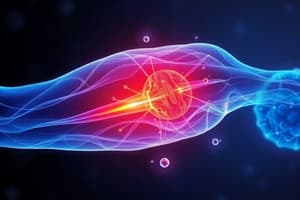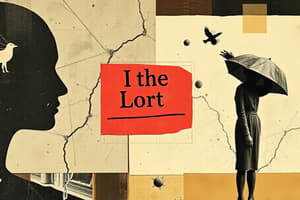Podcast
Questions and Answers
You meet a new person for the first time. Based on past experience when meeting new people you believe around 70% of people are friendly, while around 30% are unfriendly. During your conversation with the new person, they smile, say kind words and are fully engaged in the conversation (behaviours associated with friendliness). After talking to this person, you update your beliefs about their friendliness. This process is referred to as:
You meet a new person for the first time. Based on past experience when meeting new people you believe around 70% of people are friendly, while around 30% are unfriendly. During your conversation with the new person, they smile, say kind words and are fully engaged in the conversation (behaviours associated with friendliness). After talking to this person, you update your beliefs about their friendliness. This process is referred to as:
- bayesian inference (correct)
- light-above assumption
- scene schema
- law of pragnanz
what key finding from sperling's (1960) experiments supports the existence of iconic memory?
what key finding from sperling's (1960) experiments supports the existence of iconic memory?
- whole report and partial report conditions yielded identical results
- participants could recall all displayed items perfectly after a brief delay
- partial report accuracy was higher than whole report accuracy when cued immediately (correct)
- sensory memory retained meaning-based categories better than visual details
how does light travel through the eyes?
how does light travel through the eyes?
- cornea, aqueous humour, iris, pupil, lens, vitreous humour, retina, optic nerve (correct)
- lens, aqueous humour, iris, cornea, pupil, vitreous humour, retina optic nerve
- cornea, vitreous humour, iris, pupil, lens, aqueous humour, retina, optic nerve
- lens, aqueous humour, iris, pupil, cornea, vitreous humour, retina, optic nerve
What is the correct pathway in which visual information is processed?
What is the correct pathway in which visual information is processed?
What was the key finding of Sperling's partial report experiment on iconic memory?
What was the key finding of Sperling's partial report experiment on iconic memory?
Which of the following individuals does NOT seem to use a top-down process in their perception?
Which of the following individuals does NOT seem to use a top-down process in their perception?
According to George Sperling (1960) who introduced the concept of iconic memory, which kind of report is most likely to be better among others?
According to George Sperling (1960) who introduced the concept of iconic memory, which kind of report is most likely to be better among others?
What was the issue with Sperling's question about how quickly does pattern recognition copy information from sensory store to working memory?
What was the issue with Sperling's question about how quickly does pattern recognition copy information from sensory store to working memory?
what happens after light passes through the cornea of our eye?
what happens after light passes through the cornea of our eye?
What did Averbach & Coriell (1961) discover when replicating Sperling's (1960) experiment with circles as a visual cue?
What did Averbach & Coriell (1961) discover when replicating Sperling's (1960) experiment with circles as a visual cue?
Which of the following is NOT a reason why it is difficult to create perceiving machines?
Which of the following is NOT a reason why it is difficult to create perceiving machines?
Suppose you see a jar that is labelled as sugar. You immediately make out that there will be sugar in it so you go ahead and put it in your coffee. Which of the following terms best explain the judgement that was used in your decision?
Suppose you see a jar that is labelled as sugar. You immediately make out that there will be sugar in it so you go ahead and put it in your coffee. Which of the following terms best explain the judgement that was used in your decision?
Which statement best captures the key distinction between Helmholtz's Theory of Unconscious Inference and the Gestalt Principles of Organization?
Which statement best captures the key distinction between Helmholtz's Theory of Unconscious Inference and the Gestalt Principles of Organization?
Which of the following statements is true about iconic memory?
Which of the following statements is true about iconic memory?
Which of the following best illustrates the Gestalt principle of Good Continuation?
Which of the following best illustrates the Gestalt principle of Good Continuation?
What is the primary role of the perceptual span during visual tasks such as reading?
What is the primary role of the perceptual span during visual tasks such as reading?
Hyde went on a hike where he observed various objects and shared his experience. He explained how he initially thought an object on the ground was a thin pipe; it turned out to be a real snake. He initially perceived that it was a pipe because of his past experiences working in a facilities department; however, looking at the context, in a natural setting, a snake seemed more probable. Hyde’s experience demonstrates how arriving at a perception can involve a process. Based on this situation, select the statement that BEST represents the situation:
Hyde went on a hike where he observed various objects and shared his experience. He explained how he initially thought an object on the ground was a thin pipe; it turned out to be a real snake. He initially perceived that it was a pipe because of his past experiences working in a facilities department; however, looking at the context, in a natural setting, a snake seemed more probable. Hyde’s experience demonstrates how arriving at a perception can involve a process. Based on this situation, select the statement that BEST represents the situation:
What did Palmer’s (1975) experiment demonstrate about how scene schema influences our perception?
What did Palmer’s (1975) experiment demonstrate about how scene schema influences our perception?
What conclusion did Sperling come to about his memory experiments?
What conclusion did Sperling come to about his memory experiments?
How long does information last in the sensory store?
How long does information last in the sensory store?
Sperling’s experiments demonstrated that the transfer of information from iconic memory to working memory occurs through ______.
Sperling’s experiments demonstrated that the transfer of information from iconic memory to working memory occurs through ______.
In the fovea of the eye, which of the following is true?
In the fovea of the eye, which of the following is true?
Flashcards
Capital of France (example flashcard)
Capital of France (example flashcard)
Paris


